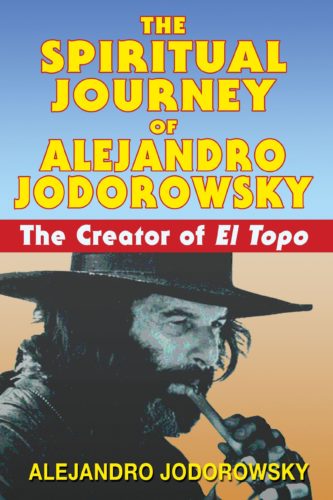 By ALEJANDRO JODOROWSKY (Park Street Press; 2005/08)
By ALEJANDRO JODOROWSKY (Park Street Press; 2005/08)
See Also: ANARCHY AND ALCHEMY: Y: THE FILMS OF ALEJANDRO JODOROWSKY
One of several autobiographical volumes written by the Chilean-born, Paris-based writer/filmmaker/spiritual guru Alejandro Jodorowsky. THE SPIRITUAL JOURNEY OF ALEJANDRO JODOROWSKY focuses on Jodorowksy’s initiation into Zen Buddhism, and you can be sure the contents, incorporating hallucinations, surrealism and perverse sexuality, are very Jodorowskyian. In other words, this is a wild, kaleidoscopic memoir that’s far from the dry and conservative account you might expect from anybody else. It’s a valuable resource for adherents of Eastern spirituality, but is also indispensable for Jodorowsky fanatics like myself.
There’s scant detail here on Jodorowsky’s films or graphic novels, much less his childhood and adolescence. It begins with Jodorowsky meeting the Japanese master Ejo Taketa in late sixties Mexico and becoming his disciple. The relationship lasts for years, with Taketa teaching Jodorowsky the importance of Koans—for the uninitiated, Koans are enigmatic questions posed by Zen masters for their disciples to meditate on (sample: “What is the sound of one hand clapping?”).
But that only covers a portion of the book, which also contains a chapter on Jodorowsky’s encounters with the surrealist painter/writer Leonora Carrington, who speaks in (seemingly) nonsensical riddles. Another covers his brief dalliance with a Mexican actress known as The Tigress, who initially befriends but then inevitably turns on him. Most memorable is a recollection of his sexual courtship with Reyna D’Assia (the daughter of the famous spiritualist Gurdjeff), who’s mastered the art of bringing men to orgasm by contracting her vaginal muscles, and who claimed Jodorowsky’s problems stem from “the pain of having a mother with a mute vagina.”
Other highlights include an arrogant American motorcycle rider who gets his ass kicked by Taketa for disrespecting the power of Koans, a recollection of how Ms. Carrington pissed off the late Luis Bunuel by decorating the white walls of his bungalow with menstrual blood handprints, and a sustained meditation session that becomes a torturous hallucinatory journey.
The concluding chapter consists of various anecdotes that illustrate how Jodorowsky has used the teachings of his Zen masters in his day-to-day life. They include brief accounts on the making of EL TOPO, THE HOLY MOUNTAIN, SANTA SANGRE and a never-filmed adaptation of DUNE, as well as a summary of Jodorowsky’s decades-long conflict with producer Allen Klein, who withheld Jodorowsky’s early films from circulation until the two finally reconciled in 2004. The final page, appropriately enough, is an advertisement for Jodorowsky’s films on DVD.
What’s never in doubt here is Jodorowsky’s intense commitment to his spirituality. It’s an integral component of all his films and graphic novels, and this entertaining book proves that this spiritual content, in opposition to those critics who claim otherwise, is pure and genuine.
